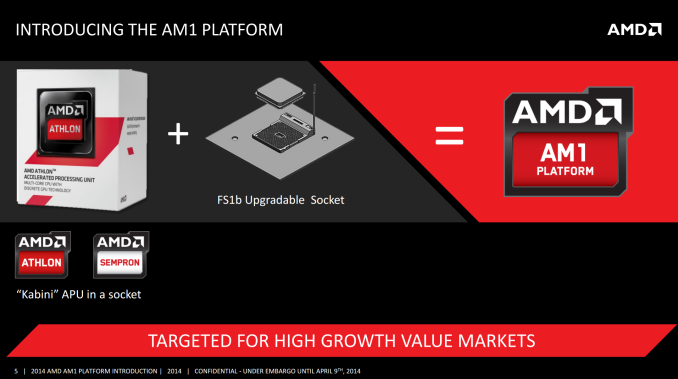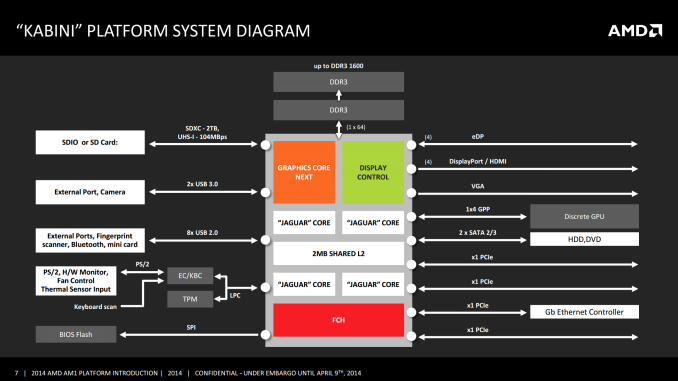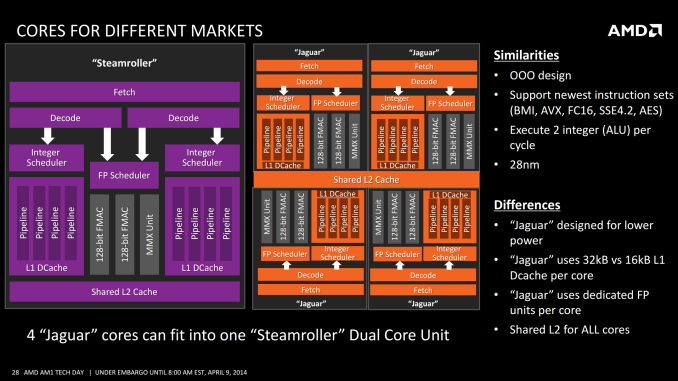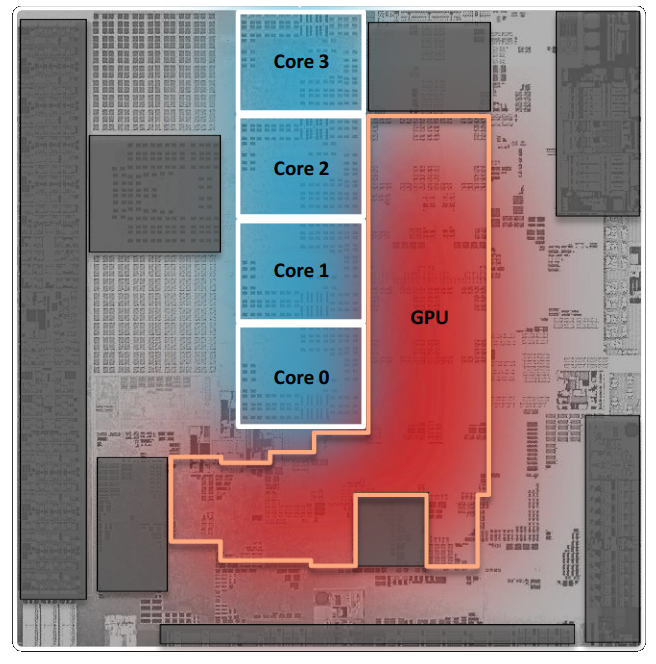AMD AM1 Kabini Part 2: Athlon 5350/5150 and Sempron 3850/2650 Tested
by Ian Cutress on May 29, 2014 2:00 PM EST
While there is a lot of focus on the mainstream desktop market, we hastily reviewed the new entrant to the low-end socketed desktop from AMD, the AM1 Kabini platform back in April. Since then we have acquired all four members of the family, the two quad core Athlon APUs and the two Sempron APUs, for testing. AMD’s movement into the upgradable tablet/desktop crossover arena is an interesting one for sure.
What Is The Point of AM1?
AMD’s reason for releasing a socketed low-power platform was derived from requests in low cost areas of the market. System integrators and companies in South America, Africa and Central Asia wanted a base system which would run an operating system which could be upgraded in the future to higher specification components, rather than sticking with a low-power but non-upgradable mobile CPU. The end result was AM1, the name given to a system using an FS1b socket with a desktop Kabini APU and an aim to build an upgradable CPU/motherboard combination for around $60.
Typically when dealing with the low cost/low power end of the spectrum, these systems are designed such that the APU is soldered on to the motherboard. When a user wants one model in particular, it comes as part of a package, much in the same way as a mobile device. In fact we even played a small game of ‘spot the desktop Kabini’ back at Computex 2013 and saw models such as the aptly named KBN-I from ECS, using the soldered A6-5200 APU:
These systems often find their way into applications that have long upgrade cycles, such as embedded and digital signage. The novelty of an upgradeable, socketed package makes most sense in the desktop arena. With low cost segments focusing more on the entry-level segmentation, AMD believe that having this upgradeability might drive pressure in the entry market towards these upgradeable PC-like devices.
AMD is marketing the series as a cheap, low powered way to go to quad core. When building a CPU architecture there is often a point in frequency scaling which is most efficient, and any deviation from that causes a less-than-linear gain in performance for power. Under this paradigm, and the importance of single core speed, the general feeling at AnandTech is that single core performance is preferred to more cores. If we can get the same multi-core performance using half the number of cores within the same power bracket, then this solution would be preferred. The final piece of that puzzle however comes in terms of design and price, both of which are points that AMD is also aiming to be competitive.
Desktop Kabini
There are a total of four AM1 APUs on the market:
| AMD AM1 Kabini APUs | ||||
| Athlon 5350 | Athlon 5150 | Sempron 3850 | Sempron 2650 | |
| CPU Cores | 4 | 4 | 4 | 2 |
| CPU Frequency | 2.05 GHz | 1.60 GHz | 1.30 GHz | 1.45 GHz |
| GPU Cores | 128 | 128 | 128 | 128 |
| GPU Frequency | 600 MHz | 600 MHz | 450 MHz | 400 MHz |
| Memory Frequency | 1600 MHz | 1600 MHz | 1600 MHz | 1333 MHz |
| L2 Cache | 2 MB | 2 MB | 2 MB | 1 MB |
| TDP | 25 W | 25 W | 25 W | 25 W |
| Official Launch Price | $59 | $49 | $39 | $31 |
Each of these APUs features up to four 28nm Jaguar cores and a 128 SP implementation of AMD's GCN GPU. We've gone over both the Jaguar and GCN architectures in previous articles, so we won't spend a lot of time recapping them here. Jaguar is the latest in AMD's line of "cat" cores, designed to go up against Intel's Atom. GCN on the other hand is a well-known GPU design from AMD as well, cut down here to fit in a much smaller die area (and thermal envelope).
The Jaguar cores in Kabini are listed as 3.1mm2, and AMD is quoting that four of these cores will fit into a single Steamroller module. Unfortunately the dimensions of a Steamroller module are not known - a 32nm SOI Bulldozer module clocked in at 30.9 mm2 for example, but no equivalent number is available for 28nm Steamroller. However some quick math shows four Jaguar cores populates 12.4 mm2. This leaves the rest of the core for the L2 cache, IGP and a large amount of IO.
In fact there are a few images that can help us predict total die size. In AMD’s slide deck, we have the following:
Given that one core is 3.1 mm2, extrapolating out gives the size of the die at 31.4x the size of a single core, or 97.3 mm2. The GPU area is approximately 5.2x the size of a core, giving ~16.1 mm2 for 128 GCN cores, compared to 12.4 mm2 for CPU cores. The Video Codec Engine and Unified Video Decoder are not part of these totals, located on other parts of the APU. The memory controller clocks in at ~9.4 mm2 and the display/IO portion runs at ~7.3 mm2.


















87 Comments
View All Comments
Eeqmcsq - Thursday, May 29, 2014 - link
"... Results are given in minutes, where the Wii itself scores 17.53; meaning that anything above this is faster than an actual Wii..."I think you mean anything "below" this number, since the measurement is in time.
Ian Cutress - Thursday, May 29, 2014 - link
'Above' being above on the graph. I'll just change the wording. I thought I had changed my explanatory template, guess it didn't save...Metalliax - Thursday, May 29, 2014 - link
Why can't review sites please start using sub 150W PSUs for these tests! You should delete your power chart completely unless you can show actual power draw with a PSU that would actually be used in such a setup. I can't believe you think you can post such nonsense with a 1250W PSU.extide - Thursday, May 29, 2014 - link
X2 ! I know you have your reason for using the 1250W PSU (so it's always the same) but the result is USELESS NUMBERS. It doesnt matter if they are comparable if they are utterly useless!easp - Thursday, May 29, 2014 - link
Good call!CU - Thursday, May 29, 2014 - link
Yes, adding haswell celerons like the g1820 and pentiums like the g3220 would be very helpful. Those cpu's plus MB's cost about the same as the Ahtlon 5350.savagemike - Thursday, May 29, 2014 - link
Agree completely. Due to similar costs and the fact I can't passively cool the AMD stuff anyway these are the Intels I'd be comparing them to for a budget build.azazel1024 - Thursday, May 29, 2014 - link
I guess you can consider the IGP benchmarks for something, because I assume it would mean some older and more casual games would be likely to run fine, where as with the Bay Trail IGP they might not. However, at least based on the benchmarks used, even the AMD's IGP here in these low end processors is not up to the task of playable frame rates. Unless I am missing something, this was 1280x1024 at LOWEST settings and they were hitting mid 20's on average frame rates. That may be playable to some and bumping it down to 1280x720 might get you in to the low 30's...but that is still barely, barely playable at best.Which makes me wonder...what would a Pentium or Celeron Haswell that might cost less manage in terms of performance. The IGP is a fair amount more capable, especially the ones with HD4400 on there...which is MASSIVELY more performance than either the Bay Trail or Kabini has...at the same price. Granted, higher TDP, but based on what I know of the actual power consumption of the processors, Haswell Celeron/Pentium might only be a litteral handful of watts more (5-10) under load and probably around the same idle.
Low end board + low end Haswell processor runs ~$100 combined...same price as the high end Kabini and WAYYYYYY more performance.
ozzuneoj86 - Thursday, May 29, 2014 - link
I don't really understand the inclusion of so many recent high end chips. For future reviews of this nature you could probably cut out all but one mid\high end CPU from each vendor, and you'd save a huge amount of benchmarking time.Along with that, it doesn't seem like I've really learned much from many of the benchmarks, since all we have to compare are high end, high TDP CPUs from the past 3 years, and these AM1 Kabini chips... as expected, the Kabinis are all similar in performance (with slight increases from least to most expensive), and the high end CPUs are significantly faster. Readers probably already knew that without the benchmarks though.
It'd be far more useful to compare these to older CPUs and their low wattage variants, such as Core 2 Duos and Quads, AM2\AM3 Athlon X2 and X4 CPUs, as well as other low power chips that are common these days, like the Ivy Bridge based Celeron 1037u, Sandy Bridge Celeron 847, AMD E-350... even an old Atom (from the Ion platform era) would be helpful for those upgrading aging HTPCs. Not to mention any of the direct competition for these chips, like the Ivy\Haswell Celerons and Pentiums.
It'd also be nice to have something to compare the dedicated GPU results to... like the Celeron J1900, or any of the CPUs mentioned above. There are many J1800\J1900 boards out there that can have a dedicated GPU installed.
Also, as others have mentioned, the power consumption numbers with such a high wattage PSU aren't very helpful either.
If its a matter of not having the hardware on hand, we're talking about low end hardware... you could probably get a decent example of almost everything I mentioned for a few hundred dollars total. Besides, I'm sure readers would gladly donate some hardware if it meant having it used in benchmarks for a few years.
Thanks for the article, I just feel like it could have been much more focused on the products being reviewed and how they compare to the competition.
ozzuneoj86 - Thursday, May 29, 2014 - link
Just remembered something else...The game benchmarks need to include older games. One or two examples of recent games that are nearly unplayable would be enough to let us know what we can't do with these... but a few old games, or even highly popular current games that don't require much power would be far more likely to influence someone's buying decisions.
Will it run Minecraft at 1080P? How about 720P? How about a few games from 4-5 years ago?